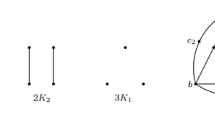Abstract
For \( q\in \mathbb {N} \), a \( q \)-star colouring of a graph \( G \) is a proper \( q \)-colouring \( f \) of \( G \) such that there is no path \( u,v,w,x \) in \( G \) with \( f(u)=f(w) \) and \( f(v)=f(x) \) (the violating path need not be induced). For \( p\ge 2 \), Shalu and Antony (Discrete Math., 2022) proved that at least \( p+2 \) colours are required to star colour a \( 2p \)-regular graph \( G \), and characterised the class \( \mathcal {G} \) of graphs \( G \) for which \( p+2 \) colours suffices in terms of graph orientations. In the second author’s thesis (2023), we provided a characterisation of the class \( \mathcal {G} \) in terms of locally constrained graph homomorphisms. In this paper, we characterise \( \mathcal {G} \) in terms of weaving patterns of edge decompositions. We also show that the study of class \( \mathcal {G} \) is tied to the theory of line graphs and line digraphs of complete graphs. We prove that if a \( K_{1,p+1} \)-free \( 2p \)-regular graph \( G \) with \( p\ge 2 \) is \( (p+2) \)-star colourable, then \( {-2} \) and \( p-2 \) are eigenvalues of the adjacency matrix of \( G \).
Access this chapter
Tax calculation will be finalised at checkout
Purchases are for personal use only
Similar content being viewed by others
References
Adanur, S.: Handbook of Weaving. CRC Press, Boca Raton (2020). https://doi.org/10.1201/9780429135828
Akleman, E., Chen, J., Gross, J.L.: Extended graph rotation systems as a model for cyclic weaving on orientable surfaces. Discret. Appl. Math. 193, 61–79 (2015). https://doi.org/10.1016/j.dam.2015.04.015
Antony, C.: The complexity of star colouring and its relatives. Ph.D. thesis, Indian Institute of Information Technology, Design & Manufacturing, (IIITDM) Kancheepuram, Chennai, India (2023). https://doi.org/10.13140/RG.2.2.28192.66561
Bagga, J.S., Beineke, L.W.: A survey of line digraphs and generalizations. DML Discrete Math. Lett. 6, 68–83 (2021). https://doi.org/10.47443/dml.2021.s109
Beineke, L.W., Bagga, J.S.: Line Graphs and Line Digraphs, Developments in Mathematics, vol. 68. Springer, Cham (2021). https://doi.org/10.1007/978-3-030-81386-4
Borodin, O.V.: Colorings of plane graphs: a survey. Discret. Math. 313(4), 517–539 (2013). https://doi.org/10.1016/j.disc.2012.11.011
Fiala, J., Paulusma, D., Telle, J.A.: Locally constrained graph homomorphisms and equitable partitions. Eur. J. Comb. 29(4), 850–880 (2008). https://doi.org/10.1016/j.ejc.2007.11.006
Fiala, J., Kratochvíl, J.: Locally constrained graph homomorphisms - structure, complexity, and applications. Comput. Sci. Rev. 2(2), 97–111 (2008). https://doi.org/10.1016/j.cosrev.2008.06.001
Gebremedhin, A.H., Manne, F., Pothen, A.: What color is your Jacobian? Graph coloring for computing derivatives. SIAM Rev. 47(4), 629–705 (2005). https://doi.org/10.1137/S0036144504444711
Hu, S.: A topological theory of weaving and its applications in computer graphics. Ph.D. thesis, USA (2013). aAI3607499
Lei, H., Shi, Y.: A survey on star edge-coloring of graphs. Adv. Math. 50(1), 77–93 (2021)
Nešetřil, J., de Mendez, P.O.: Colorings and homomorphisms of minor closed classes. In: Aronov, B., Basu, S., Pach, J., Sharir, M. (eds.) Discrete and Computational Geometry. Algorithms and Combinatorics, vol. 25, pp. 651–664. Springer, Heidelberg (2003). https://doi.org/10.1007/978-3-642-55566-4_29
Ren, Y., Panetta, J., Chen, T., Isvoranu, F., Poincloux, S., Brandt, C., Martin, A., Pauly, M.: 3D weaving with curved ribbons. ACM Trans. Graph. 40(4), 127 (2021). https://doi.org/10.1145/3450626.3459788
Shalu, M.A., Antony, C.: Star colouring of bounded degree graphs and regular graphs. Discret. Math. 345(6), 112850 (2022). https://doi.org/10.1016/j.disc.2022.112850
West, D.B.: Introduction to Graph Theory, 2nd edn. Prentice Hall, Upper Saddle River (2001)
Acknowledgement
We thank three anonymous referees for their careful reading and valuable suggestions.
Author information
Authors and Affiliations
Corresponding author
Editor information
Editors and Affiliations
Rights and permissions
Copyright information
© 2024 The Author(s), under exclusive license to Springer Nature Switzerland AG
About this paper
Cite this paper
Shalu, M.A., Antony, C. (2024). Star Colouring of Regular Graphs Meets Weaving and Line Graphs. In: Kalyanasundaram, S., Maheshwari, A. (eds) Algorithms and Discrete Applied Mathematics. CALDAM 2024. Lecture Notes in Computer Science, vol 14508. Springer, Cham. https://doi.org/10.1007/978-3-031-52213-0_22
Download citation
DOI: https://doi.org/10.1007/978-3-031-52213-0_22
Published:
Publisher Name: Springer, Cham
Print ISBN: 978-3-031-52212-3
Online ISBN: 978-3-031-52213-0
eBook Packages: Computer ScienceComputer Science (R0)




